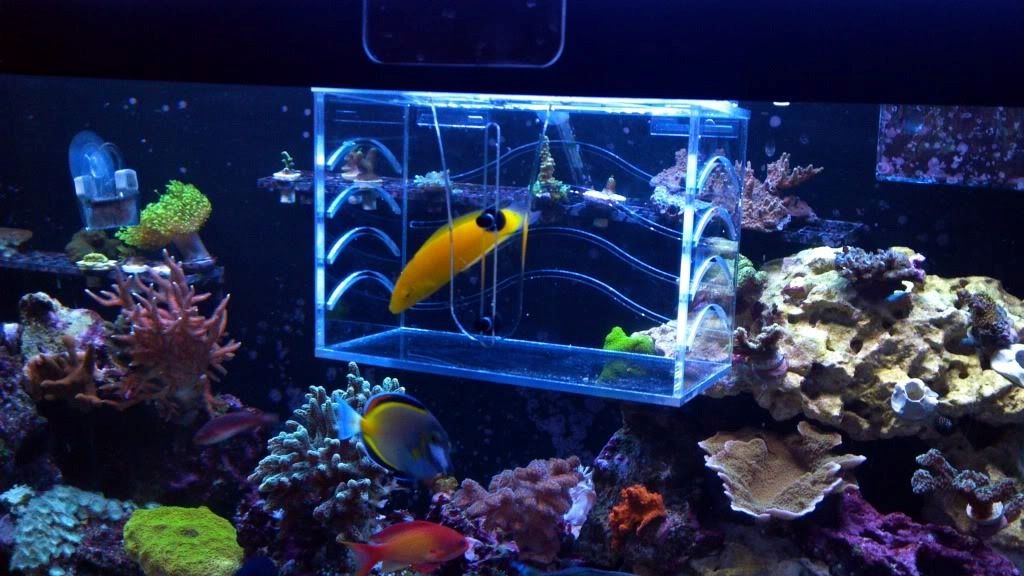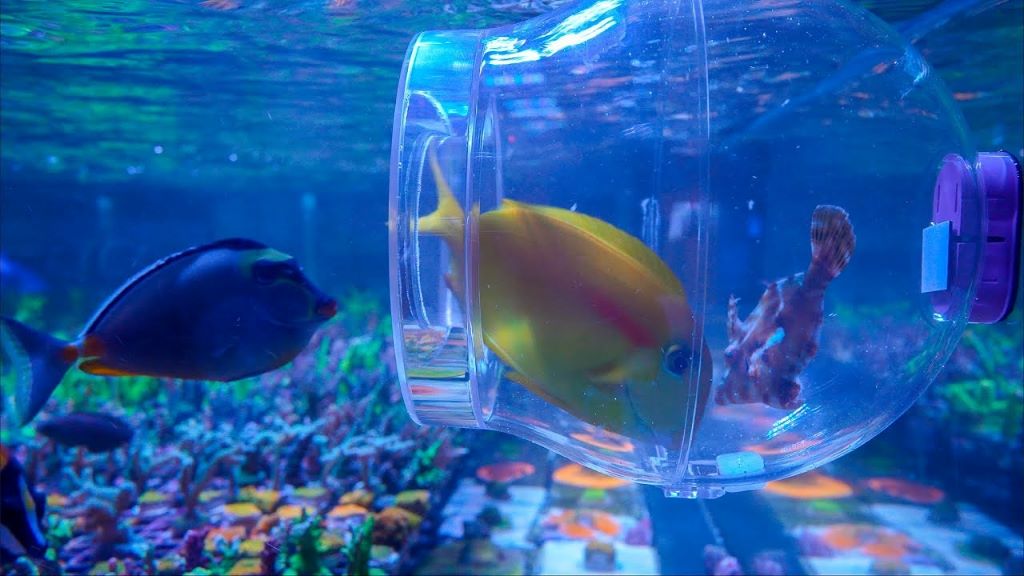Reef tanks are mesmerizing worlds of vibrant colors and fascinating creatures. But sometimes, you need to catch a fish, whether it’s for its own well-being, the safety of other inhabitants, or simply to re-home it. Learning how to catch fish in a reef tank is an essential skill for every aquarist. This task, however, can be surprisingly challenging. Fish are quick, agile, and masters of navigating the intricate labyrinth of your reef.
Fear not, fellow aquarists! This comprehensive guide will equip you with 12 effective methods to catch fish in your reef tank, complete with reviews, pros, cons, and even a handy FAQ section. Let’s dive in!
-
The Classic Fish Net
Ah, the trusty fish net. A staple in the aquarist’s toolkit. While seemingly straightforward, using a fish net effectively in a reef tank requires finesse.
- Review: This method is often the first one people try. It can be successful for slow-moving or less skittish fish, but it can be quite stressful for both the fish and the aquarist, especially in a densely populated reef.
- Pros: Readily available, inexpensive, and generally safe for the fish if used gently.
- Cons: Can be difficult to maneuver in tight spaces, may damage corals, and can be stressful for fish.
- Pro Tip: Use two nets. Gently herd the fish towards a corner or open area using one net, then scoop it up with the other.
-
The Bottle Trap
This simple yet effective trap lures the fish into a bottle or jar with bait, then prevents its escape.
- Review: A popular choice among reef keepers, the bottle trap is particularly useful for catching shy or nocturnal fish.
- Pros: Relatively inexpensive, easy to set up, and less stressful for the fish than chasing it with a net.
- Cons: Can take time for the fish to enter the trap, may not be suitable for all fish species.
- Pro Tip: Use a clear bottle or jar to reduce the fish’s anxiety. Place the trap in an area where the fish frequently visits.
-
The Acclimation Box Trap

Similar to the bottle trap, this method utilizes an acclimation box with a trap door.
- Review: A more sophisticated version of the bottle trap, the acclimation box trap offers a larger space and is less confining for the fish.
- Pros: Less stressful for the fish, allows for observation while the fish is contained.
- Cons: Can be more expensive than a bottle trap, may require modification to create a trap door.
- Pro Tip: Place live food or the fish’s favorite treat inside the box to entice it to enter.
-
The Fish Trap with a Funnel Entrance
This commercially available trap features a funnel-shaped entrance that allows fish to easily swim in but makes it difficult for them to find their way out.
- Review: Highly effective and widely used by both hobbyists and professionals.
- Pros: Easy to use, suitable for a variety of fish sizes, minimizes stress on the fish.
- Cons: Can be more expensive than DIY traps.
- Pro Tip: Choose a trap size appropriate for the fish you’re trying to catch.
-
The Hand-Feeding Trap
This method involves building trust with the fish by hand-feeding it regularly, then gently guiding it into a net or container.
- Review: Requires patience and time but can be very rewarding, especially for building a bond with your fish.
- Pros: Minimizes stress, strengthens the relationship between the aquarist and the fish.
- Cons: Time-consuming, may not work with all fish species.
- Pro Tip: Start by offering food from a distance, gradually moving closer as the fish becomes more comfortable.
-
The Night Catch
Many fish are less active and easier to catch when the lights are off.
- Review: A surprisingly effective method, especially for diurnal fish that become less alert at night.
- Pros: Fish are less likely to struggle, reducing the risk of injury.
- Cons: Requires working in low-light conditions, may disturb nocturnal tank inhabitants.
- Pro Tip: Use a red light, as it’s less likely to startle the fish.
-
The Siphon Trap
This method uses a siphon hose to gently suck the fish into a container.
- Review: Can be effective for small fish or those hiding in crevices, but requires careful handling to avoid injuring the fish.
- Pros: Useful for hard-to-reach areas.
- Cons: Can be stressful for the fish, requires practice to control the suction.
- Pro Tip: Use a large-diameter hose to reduce the suction pressure.
-
The Coral Removal Method
For particularly elusive fish, you may need to temporarily remove some of the rockwork or corals to create more open space for catching.
- Review: A last resort option, as it can be disruptive to the tank’s ecosystem.
- Pros: Provides better access to the fish.
- Cons: Labor-intensive, stressful for all tank inhabitants, increases the risk of damaging corals.
- Pro Tip: Plan carefully and have a temporary holding tank ready for the displaced corals and fish.
-
The Angling Method
Believe it or not, you can actually “fish” in your reef tank using a small hook and line baited with the fish’s favorite food.
- Review: Requires patience and a steady hand, but can be surprisingly effective for curious fish.
- Pros: Can be less stressful than chasing the fish with a net.
- Cons: Requires practice, there’s a risk of the fish swallowing the hook.
- Pro Tip: Use a barbless hook to minimize the risk of injury.
-
The Sedation Method
In some cases, sedation may be necessary, especially for large or aggressive fish.
- Review: Should only be used as a last resort and under the guidance of a veterinarian or experienced aquarist.
- Pros: Makes catching the fish much easier, reduces stress and risk of injury.
- Cons: Requires specialized knowledge and careful dosage, potential side effects for the fish.
- Pro Tip: Research appropriate sedatives for your fish species and follow the instructions carefully.
-
The Two-Tank Method
If you’re setting up a new tank or performing a major rescape, transferring the fish to a temporary tank can make catching them much easier.
- Review: A convenient option if you’re already planning to move the fish.
- Pros: Less stressful for the fish, allows for a thorough cleaning of the main tank.
- Cons: Requires a second tank and equipment.
- Pro Tip: Ensure the temporary tank is properly cycled and has similar water parameters to the main tank.
-
The Professional Service
If all else fails, consider hiring a professional aquarium service to catch the fish for you.
- Review: A stress-free option, but can be expensive.
- Pros: Expertise and specialized equipment, minimizes risk to the fish and the reef.
- Cons: Costly, may require scheduling in advance.
- Pro Tip: Obtain quotes from several service providers and check their references.
Frequently Asked Questions
Q: Why is it so difficult to catch fish in a reef tank?
A: Reef tanks offer numerous hiding places and obstacles, making it challenging to maneuver nets or traps. Additionally, fish are naturally quick and evasive, especially in a confined environment.
Q: What is the least stressful method for catching fish?
A: The least stressful methods are typically passive ones like the bottle trap, acclimation box trap, or hand-feeding trap. These methods allow the fish to enter the trap voluntarily, minimizing stress and potential injury.
Q: How can I prevent damaging my corals while catching fish?
A: Avoid chasing the fish through delicate coral structures. Use gentle movements and consider removing some corals temporarily if necessary.
Q: What should I do with the fish once I catch it?
A: Once caught, place the fish in a separate quarantine tank or a holding container with clean, oxygenated water. This allows you to observe the fish for any signs of stress or injury.
Q: Can I use a regular freshwater fish net in my saltwater reef tank?
A: While you can use a freshwater net in a saltwater tank, it’s recommended to use a dedicated saltwater net. Saltwater can corrode metal parts over time, and some freshwater nets may contain chemicals that could be harmful to saltwater fish and invertebrates.
Conclusion
Catching fish in a reef tank requires patience, strategy, and the right tools. By understanding the different methods available and choosing the one best suited for your specific situation, you can successfully capture your elusive fish while minimizing stress and potential harm to your reef inhabitants. Remember, the key is to remain calm, patient, and persistent. Happy fishing!




